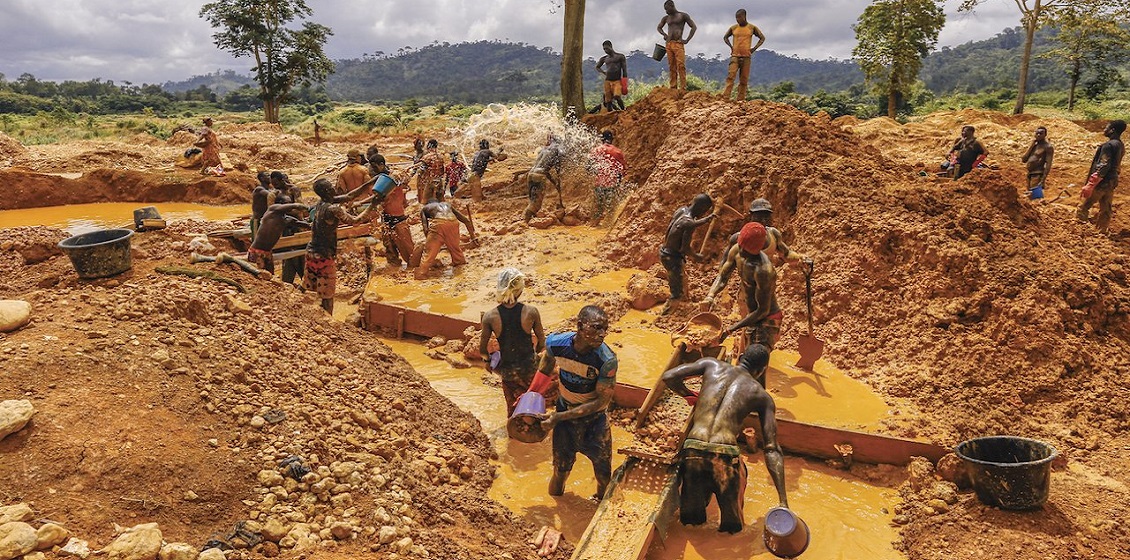Illegal Gold Mining in Zambia and Its Environmental Impact on Climate Change
How unregulated mining operations are devastating ecosystems and undermining Zambia's climate resilience

Illegal gold mining has exploded in Zambia over the last decade, fuelled by soaring gold prices, widespread poverty and a glaring lack of regulatory oversight. Artisanal miners, often known as "jerabos," have swarmed remote areas of North-Western, Lusaka and Central Provinces. There, they carve out pits along riverbanks and old mine dumps, operating without permits or any environmental safeguards. Despite the government's efforts to formalize the sector by issuing over 1,000 artisanal mining licenses in 2024, illicit operations continue to spread unchecked.
Notable hotspots for illegal gold mining include Kasempa, Mufumbwe, Lufunsa, Mpika, Lumezi as well as other parts of Eastern and Western Provinces. Unlicensed miners in these regions are actively polluting vital water bodies like the Dengwe, Lufupa and Kafue Rivers. In Mkushi and Chisamba (Central Province), illegal pits and trenches now scar agricultural land once designated for farming under the Farm Block Development Programme. This weak law enforcement, coupled with the immense profitability of gold yields often concealed from official statistics, has transformed informal mining into a multi-billion-kwacha underground economy.

Illegal mining isn't just stealing our minerals, but it's stealing our children's future. The environmental damage we're seeing today will take generations to repair and is making Zambia more vulnerable to climate disasters.
- Environmental Minister, Zambia
Devastating Environmental Impacts
The consequences of this unregulated activity are severe and far-reaching:
• Water Contamination: Unregulated wash-plants discharge harmful substances like mercury, cyanide and acidic tailings directly into waterways. This drastically distorts pH levels and is lethal to aquatic life. In Kasempa, for instance, water-borne gold-bearing earth materials have rendered local streams unusable for drinking or irrigation. Similar contamination has been documented in the Lunga, Chibefwe and Momboshi Rivers, jeopardizing drinking water and food security for thousands.
• Soil Degradation and Deforestation: The excavation of shallow alluvial deposits causes massive land disturbance. Illegal miners frequently clear critical riparian forests to access gold-bearing gravels. This action releases stored carbon into the atmosphere and severely reduces biodiversity. In the Northwestern Province alone, thousands of hectares of topsoil have been stripped and discarded as waste rock, leaving the land infertile and highly vulnerable to erosion.
• Compromised Air Quality: Fine particles, often laden with heavy metals, become airborne during dry seasons. This poses significant respiratory risks to both mine workers and nearby communities. Chronic exposure to this dust exacerbates lung diseases, yet air quality monitoring remains virtually non-existent in these informal mining zones.
Increase in illegal mining since 2015
Annual value of illegal gold trade
Artisanal miners operating illegally
Critical Climate Change Implications
The environmental damage from illegal mining carries profound climate change implications that we cannot ignore:
• Loss of Carbon Sequestration: Widespread deforestation along river corridors and around mining camps releases substantial amounts of CO₂. Satellite analyses suggest that artisanal mining in Zambia contributes to regional deforestation rates of up to 1.5% per year, far outpacing current reforestation efforts. This reduced tree cover undermines Zambia’s natural carbon sink potential, severely hampering national climate mitigation targets.
• Altered Hydrological Cycles: Mine-driven siltation raises riverbeds, leading to an increased risk of flooding during the rainy season and reduced groundwater recharge in dry seasons. These altered water flows exacerbate water scarcity for downstream communities already struggling with shifting precipitation patterns linked to climate change.
• Emissions from Fossil-Fuel Equipment: While artisanal miners typically rely on manual labor, there's a growing trend towards semi-mechanized illegal operations that deploy diesel powered pumps and excavators. The increasing prevalence of such equipment contributes additional greenhouse gas emissions, further entrenching Zambia’s vulnerability to global warming.
Illegal Mining's Climate Impact
CO₂ emissions annually
of Zambia's annual forest loss
CO₂ from diesel equipment
A Call to Action for a Sustainable Future
The alarming rise of illegal gold mining in Zambia presents a multifaceted threat. It's decimating water quality, degrading soils, eroding forests and simultaneously undermining local livelihoods and the nation’s climate resilience. Left unchecked, Zambia faces severe climate consequences, including prolonged droughts due to disrupted rainfall patterns.
By combining robust enforcement, inclusive formalization, targeted site rehabilitation and climate-smart land-use planning, Zambia has an opportunity to curtail environmental damage, reduce greenhouse gas emissions, and transform artisanal gold mining into a sustainable contributor to rural development. Proactive policy implementation today will safeguard Zambia’s natural capital and ensure that future generations inherit an environment capable of withstanding a warming world.
Deliberate measures must be taken now, including but not limited to:
• Strengthen Enforcement and Monitoring: Empower the Zambia Environmental Management Agency (ZEMA) and the Water Resources Management Agency (WARMA) to effectively regulate and monitor mining activities.
• Rehabilitate Legacy Sites: Foster collaboration between the government, communities, traditional leadership and non-profit organizations to identify and rehabilitate degraded former mining sites.
• Integrate Climate-Smart Land Management: Promote agroforestry in abandoned mine sites to rebuild soil structure, capture CO₂ and diversify livelihoods for displaced farmers.
Water Pollution Crisis
Miners use 10-15 tonnes of mercury annually, with 70-80% discharged directly into waterways. River samples show mercury levels 50x above WHO safety limits, destroying aquatic ecosystems and contaminating drinking water.
Deforestation Surge
8,000+ hectares of riparian forests are cleared annually for mining operations. This deforestation reduces carbon sequestration by approximately 200,000 tonnes CO₂/year while destroying biodiversity corridors.
Toxic Tailings & Air Pollution
18 major tailings dam failures since 2020 have released toxic slurry into river systems. Air quality near mining sites shows PM2.5 levels exceeding 300 µg/m³ (WHO limit: 25 µg/m³), causing respiratory diseases in 40%+ of local residents.

